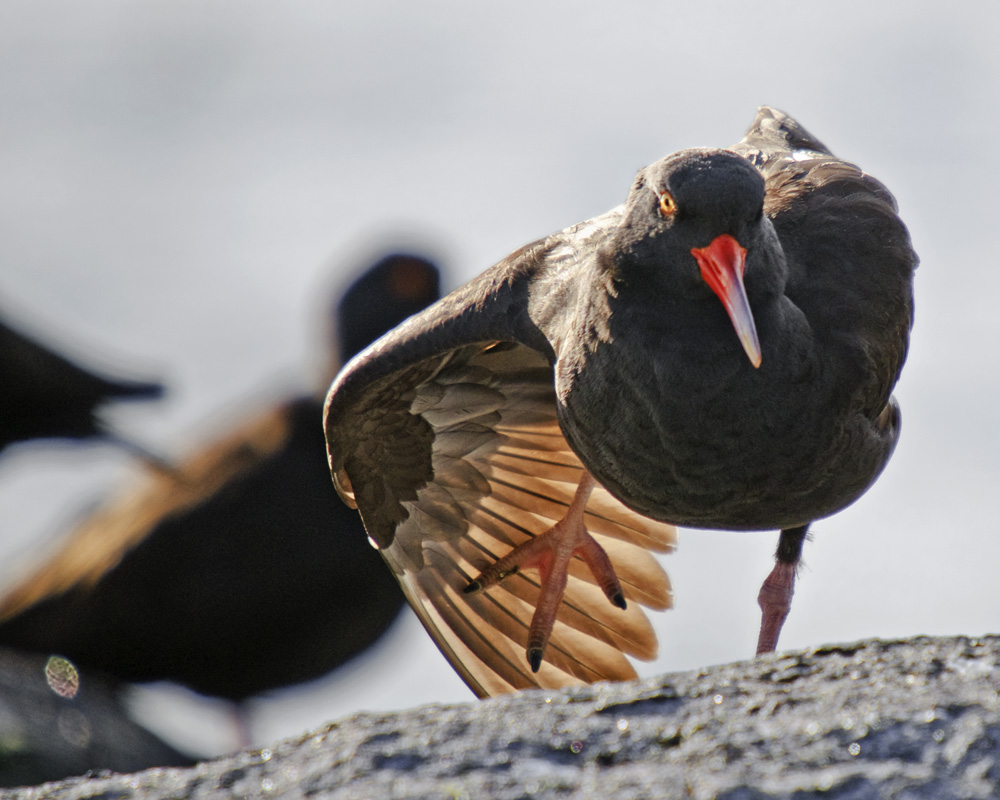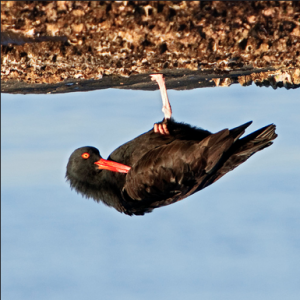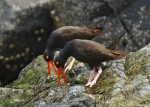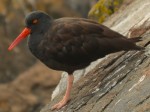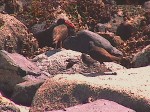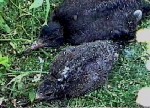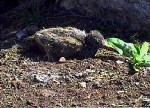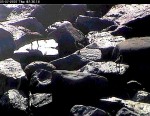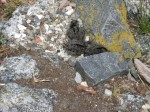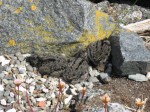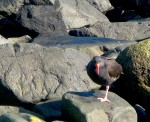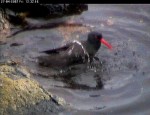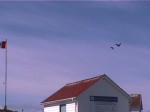Usually up to 6 pairs of the Black Oystercatcher, Haematopus bachmani nest at Race Rocks . They are also winter residents on the island, with numbers up to 100 individuals at times .
This link will connect you with the log showing the many
entries referring to Haematopus bachmani at Race Rocks.
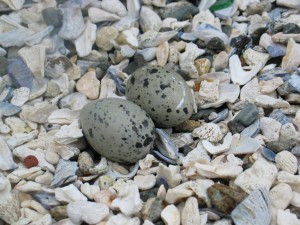 An Oystercatcher nest demonstrates the fine art of camouflage
An Oystercatcher nest demonstrates the fine art of camouflage
Classification:
Domain Eukarya
Kingdom Animalia
Phylum Chordata
Subphylum Vertebrate
Class Aves
Subclass Neornithes
Superorder Neognathae
Order Charadriiformes
Suborder Charadrii
Family Haematopodidae
Genus Haematopus
Species bachmani
Common Name :
Black Oystercatcher
Images for this slide show of mating Black oystercatchers were taken on the remote camera 5 by PB. May 29, 2006
- The communication sounds and behaviours of Oystercatchers as they meet are memorable : Ryan Murphy photo
- Photos of Black oystercatchers by Ryan Murphy
This video of the black oystercatcher on the nest in June 2007 was screen-captured from camera 2 which was placed two metres from the nest for the duration of incubation.
June 24, 2007: Hatching day! By the end of the day three chicks are active. This video by Garry Fletcher is a compilation of events throughout the day.
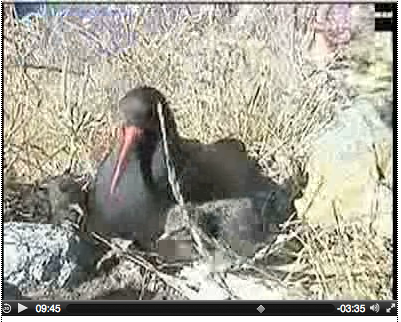
Link to this post from June 22, 2008 for the hatch of Black Oystercatchers near the boathouse captured from a live webcast on a video camera.
- Parents and several day old chick.
- The young chicks will stay very still when attempting to hide.
- Young chick
- PB recorded these images from remote cam 5 of two of the chicks on July 5 /07.
- See article linked on precocial birds below
- Note there were only three eggs. The shell fragment only appears as a fourth.
- Mar 1, 2008 photo by Natan.
- April 2007 Black oystercatcher bathing in freshwater pool. Photo by P. Birley by Remote camera
- The protective instincts of the black oystercatcher is shown here as it harasses a bald eagle.
 See this video on Black Oystercatcher Behaviour
See this video on Black Oystercatcher Behaviour
For an interesting article on precocial birds such as these oystercatchers see this link.
The black oyster catcher is a jet black bird with a long red beak and pink legs. They grow to 43-44 cm, relatively large for shorebirds. The male and female adult birds are alike in appearance, but juveniles are dull brown. Race Rocks is home to at least six pairs during early May. The birds leave in early fall and return in later December, in numbers up to 30. In the Race Rocks Christmas bird counts numbers as high as 64 in 1997 have been recorded.
| 1997 | 1998 | 1999 | 2000 | 2001 | 2002 | 2003 | 2004 | 2005 | 2006 | 2007 | 2008 |
| 64 | 17 | 1 | 25 | 16 | 39 | storm | 16 | 35 | 22 | 0 | storm |
| 2009 | 2010 | 2011 | 2012 | 2013 | 2014 | 2015 | 2016 | 2017 | 2018 | 2019 | 2020 |
| 57 | 32 | 60 | 36 | 30 | 3 | 40 | — | — | — | — | — |
The birds often use distracting displays, pretending to have a broken wing or surprising other birds that invade their nests, but are otherwise non-territorial. Both parents incubate two or three eggs on average, and mates may stay together for several years. Locally, since there are no oysters, the bird is not so aptly named, but it does prey upon a variety of intertidal shellfish, including limpets, chitons and various snails. Birds of the same family occupying the same ecological niche are found throughout the shorelines of the world.
Their long, chisel-like beak is perfect for prying the shells open to feed on the soft flesh inside. The skull to the left was the product of predation by a river otter in 2001. The presence of the black oyster catcher nesting areas can be noted upon the discovery of piles of empty shells in the nooks and crannies of Race Rocks. Analysis of the different shells found in these piles has been done and it serves as an indicator of shellfish species diversity on the island, as well as the food web of the oystercatchers.
See the results of the Fall 1999 collection of shells from the midden of the oystercatchers.
Also go to the Lab on the Ecological Niche of the Black Oyster-catcher.
see this Video by Paul Omole of a Black Oystercatcher Feeding. –Sounds of Foghorn in the background .
Other Members of the Class Aves at Race Rocks.
and Image File |
 The Race Rocks taxonomy is a collaborative venture originally started with the Biology and Environmental Systems students of Lester Pearson College UWC. It now also has contributions added by Faculty, Staff, Volunteers and Observers on the remote control webcams. The Race Rocks taxonomy is a collaborative venture originally started with the Biology and Environmental Systems students of Lester Pearson College UWC. It now also has contributions added by Faculty, Staff, Volunteers and Observers on the remote control webcams.
This file was originally started by Stewart Maudsley, Dec. 2001. |
